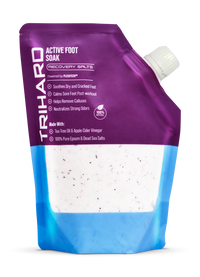Athlete's foot - Symptoms, Causes, and Treatment
Athlete's foot is a common type of fungal infection that affects the skin on the feet. It may be hard to tell if you have athlete's foot, but there are certain signs that can help you diagnose it.
In this article we are going to cover what athlete’s foot is and what causes it, what the symptoms are, how to prevent athlete’s foot and how to treat it.
Let’s get started.
What is athlete's foot?

Athlete's foot is a fungal skin infection that causes itchiness, flaking, and cracking of the skin. To detect this condition, look for these signs:
- There may be white and soggy skin between the toes
- It is possible for the soles of the feet to become dry and scaly
- There may be red skin all over the foot, as well as blistering
Typically, this condition occurs among people whose feet are very sweaty, wear tight and closed shoes, and use public showers and pools.
How common is athlete’s foot?
Athlete's foot is a very common condition, approximately 15% to 25% of the population are estimated to suffer from athlete's foot at any given time. There is a higher risk of getting it in men and older people.
What causes athlete’s foot?
Athlete's foot is caused by dermatophytes, a fungus. The fungi can enter the top layer of the skin through small cracks or wounds.
In order for these fungi to be transmitted, they must be directly in contact with the skin or contact skin flakes. It is therefore easy to contract the infection by stepping on infected skin flakes in communal showers.
For the fungus to spread, moisture and warmth are necessary. And because our feet are often moist and warm, they thrive in this environment. And to make matters worse, we also have keratin on our feet, which is a food source for fungi.
What are the symptoms of athlete’s foot?

Athlete's foot can affect one or both feet and the most common symptoms include:
- An itchy sensation, particularly between the toes
- Scaling, dryness, and cracking between the toes
- An intense burning or stinging sensation
- Excessive redness and inflammation of the skin
- Oozing, crusting, blistering, and swelling.
What happens if athlete’s foot is left untreated?
Athlete's foot does not cause serious problems in healthy individuals, but if left untreated, athlete's foot can spread to a nail and develop into a fungal nail infection.
Since the fungus can spread to other areas of skin like the hands, it is possible for the infection to spread to other warm, moist parts of the body like the groin (but that rarely happens).
It is rare for athlete's foot to go away on its own. It needs to be treated in order to kill the fungus and prevent it from spreading, and hygiene is crucial to prevent it from spreading elsewhere.
Bacterial infections are rare in athlete's foot, but they may occur in severe cases.
How to prevent athlete’s foot
Taking preventive measures can help you avoid athlete's foot, so here are some suggestions:
1. Wear sandals more often
To encourage proper foot airflow, wear sandals whenever possible.
2. Wash your feet every day
Keep your feet clean by washing them every day. To maintain clean and hygienic skin, we recommend using TRIHARD's Active Foot Exfoliating Soap.

Our soap contains Dead Sea Mud, Active Charcoal, 100% Natural Red Algae, Biodegradable Scrub, and Pumice Stone for effective exfoliation.
Our product soothes your skin, prevents calluses, and prevents the growth of fungus.
3. Change your socks at least once a day
If you have sweaty feet, you should change your socks at least once per day.
4. Use a different pair of shoes
Make sure you wear a different pair of shoes every day so that your shoes can dry between wears.

You can remove bacteria from your shoes by disinfecting and deodorizing them with TRIHARD's Active Foot Pre & Post Workout Spray. It helps eliminate bacteria and relieves foot pain thanks to natural oils such as Argan, Jojoba, and Obliphica.
5. Wear waterproof shoes around wet areas
Wear waterproof sandals or shoes around public pools, showers, and locker rooms.
How to treat athlete’s foot
Athlete's foot is easily treatable if diagnosed early. The majority of mild cases can be treated with lotions, creams, gels, or sprays available at pharmacies without a prescription. These products contain ingredients that prevent fungus growth or kill it.
If you suspect you have athlete's foot, you can purchase topical antifungal creams or lotions over-the-counter, including Clotrimazole, Econazole, and Ciclopirox.
If the condition is more severe, you may need a stronger antifungal, like Terbinafine or Itraconazole, which come in oral pills or cream forms.
Keep your feet clean and dry during and after treatment. Due to fungi's need for moist environments, if you keep your feet dry, it won't be able to reproduce.
Consult a doctor if the lesions do not improve after 2 weeks, if you suffer from persistent athlete's foot, or any other infection that causes irritation in your feet. The doctor will determine which treatment is best for you based on your condition.
When to call the doctor
There are several reasons why you may need medical attention, including:
- If two weeks have passed since antifungal creams were applied and lesions have not improved.
- Whenever you suffer from severe itching or pain that interferes with your everyday life.
- Whenever your feet develop blisters or ulcers.
- Recurring athlete's foot infection.
- If you have diabetes or other health conditions that compromise your immune system.
Your doctor will examine your symptoms and prescribe antibiotics if necessary.
Questions to ask your doctor
Make a list of questions to ask your doctor before your appointment so you can get the most out of it. Here are some examples:
- Can you tell me why I am experiencing these symptoms?
- Are there any tests I can take to confirm the diagnosis?
- What treatment options are available to me?
- Is this condition temporary or does it last for a long time?
- Is it okay if I wait and see if it goes away on its own?
- Is there anything I can do to prevent the infection from spreading?
- While the condition heals, what should I do to take care of my skin?
Summary
Athlete's foot is a fungal skin infection that causes itching, flaking, and cracking of the skin. You are most likely to experience it if you sweat a lot, wear closed shoes, or use communal showers or pools.
Moisture and warmth are needed for the fungus to spread on the skin, and if left untreated, it may spread to other warm, moist parts of the body. In order to prevent the spread of infection, hygiene is crucial.
You can prevent it by washing your feet every day, using TRIHARD's Active Foot Exfoliating Soap, and changing your socks regularly. Deodorize and disinfect your shoes by using TRIHARD's Active Foot Pre & Post Workout Spray.
Athlete's foot can be treated with topical antifungal creams, gels, or sprays that stop the growth of fungus or kill it. More severe cases may require a stronger antifungal, such as Terbinafine or Itraconazole.
When to call the doctor: If antifungal creams do not improve lesions within two weeks, or if blisters develop.






























Leave a comment